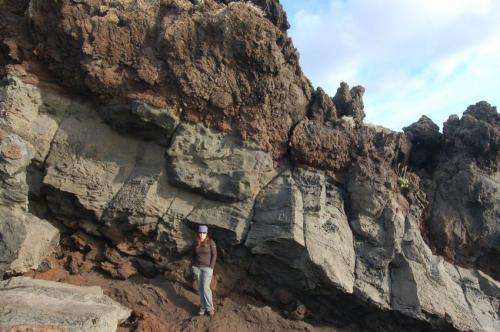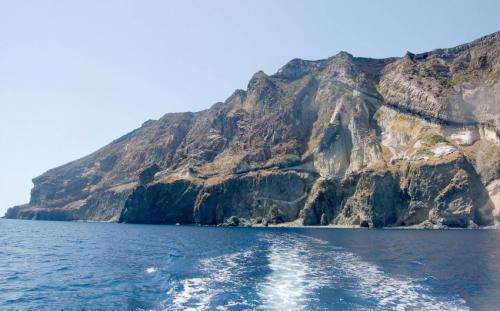Shattering past of the 'island of glass'

A tiny Mediterranean island visited by the likes of Madonna, Sting, Julia Roberts and Sharon Stone is now the focus of a ground-breaking study by University of Leicester geologists.
Pantelleria, a little-known island between Sicily and Tunisia, is a volcano with a remarkable past: 45 thousand years ago, the entire island was covered in a searing-hot layer of green glass.
Volcanologists Drs Mike Branney, Rebecca Williams and colleagues at the University of Leicester Department of Geology have been uncovering previously unknown facts about the island's physical history.
And their study, published in Geology earlier this year, also provides insights into the nature of hazardous volcanic activity in other parts of the world.
Describing the volcanic activity on the island, Dr Branney said: "A ground-hugging cloud of intensely hot gases and volcanic dust spread radially out from the erupting volcano in all directions.
"Incandescent rock fragments suspended in the all-enveloping volcanic cloud were so hot, molten and sticky that they simply fused to the landscape forming a layer of glass, over hills and valleys alike. The hot glass then actually started flowing down all the slopes rather like sticky lava. 'Ground zero' in this case was the entire island – nothing would have survived – nature had sterilized and completely enamelled the island.

"Today Pantelleria is verdant and has been re-colonised, but even as you approach it by ferry you can see the green layer of glass covering everything - even sea cliffs look like they've been draped in candle wax. Exactly how this happened has only recently come to light."
The Leicester team have reconstructed how the incandescent density current gradually inundated the entire island. They carefully mapped-out how the chemistry of the glass varies from place to place, and use this to show in unparalleled detail how the ground-hugging current at first was restricted to low, central areas, but then gradually advanced radially towards hills, eventually overtopping them all. Even more remarkably, the devastating current then gradually retreated from hill-tops, and the area covered by it gradually decreased so that, by the end of the eruption, only lower ground, close to the volcano continued to be immersed by it. Such advance-retreat behaviour may be typical of catastrophic currents in nature, such as at other volcanoes, and it may help us better understand undersea currents that are triggered by earthquakes.
"We are trying to ascertain whether this volcanic eruption was just a freak, oddball event. Well, it turns out that the delightful island, now used as a quiet getaway by celebrities, has been the site of at least five catastrophic eruptions of similar type.
"The remarkable volcanic activity on the island was not just a one-off. And as the volcano continues to steam away quite safely, it seems reasonable that in thousands of years time, it may once again erupt with devastating effect.
"Our investigations should help us understand what happens during similar and much larger explosive eruptions elsewhere around the world, such as the Yellowstone–Snake River region of USA".
More information: Williams R., Branney, M.J., Barry, T.L. 2014. Temporal and spatial evolution of a waxing then waning catastrophic density current revealed by chemical mapping. Geology 42:107-11 (Open Access)
Journal information: Geology
Provided by University of Leicester


















